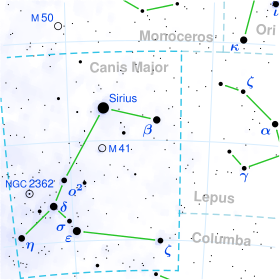NGC 2362
| NGC 2362 | |
|---|---|
 NGC 2362 in Canis Major | |
| Observation data (J2000 epoch) | |
| Right ascension | 07h 18m 41.0s[1] |
| Declination | −24° 57′ 18″[1] |
| Distance | 4.83 ± 0.97 kly (1.480 ± 0.296 kpc)[1] |
| Apparent magnitude (V) | 3.8[2] |
| Apparent dimensions (V) | 6′[2] |
| Physical characteristics | |
| Mass | ≥500[3] M☉ |
| Radius | ~3 pc[4] |
| Estimated age | 5.0 Myr[1] |
| Other designations | Caldwell 64, Cr 136[5] |
| Associations | |
| Constellation | Canis Major |
NGC 2362, also known as Caldwell 64, is an open cluster of stars in the southern constellation of Canis Major. It was discovered by the Italian court astronomer Giovanni Batista Hodierna, who published his finding in 1654.[4] William Herschel called it a "beautiful cluster", while William Henry Smyth said it "has a beautiful appearance, the bright white star being surrounded by a rich gathering of minute companions, in a slightly elongated form, and nearly vertical position". In the past it has also been listed as a nebula, but in 1930 Robert J. Trumpler found no evidence of nebulosity.[6] The brightest member star system is Tau Canis Majoris, and therefore it is sometimes called the Tau Canis Majoris Cluster.
The cluster is located at a distance of approximately 1.48 kpc from the Sun,[1] and appears associated with the giant nebula Sh2-310 that lies at the same distance,[7] about one degree to the east. This giant H II region is being ionized by the brighter members of the NGC 2362 cluster.[4]
NGC 2362 is a relatively young 4–5 million years in age[3] but is devoid of star-forming gas and dust, indicating that the star formation process has come to a halt.[4] It is a massive open cluster, with more than 500 solar masses,[3] an estimated 100-150 member stars, and an additional 500 forming a halo around the cluster. Of these cluster members, only around 35 show evidence of a debris disk.[3] There is one slightly evolved O-type star, Tau Canis Majoris, and around 40 B-type stars still on the main sequence. Only one candidate classical Be star has been found, as of 2005.[4]
Gallery
[edit]References
[edit]- ^ a b c d e Wu, Zhen-Yu; et al. (November 2009), "The orbits of open clusters in the Galaxy", Monthly Notices of the Royal Astronomical Society, 399 (4): 2146–2164, arXiv:0909.3737, Bibcode:2009MNRAS.399.2146W, doi:10.1111/j.1365-2966.2009.15416.x, S2CID 6066790
- ^ a b Finlay, Warren H. (2014), Concise Catalog of Deep-sky Objects, The Patrick Moore Practical Astronomy Series (2nd ed.), Springer Science & Business Media, p. 207, ISBN 978-3-319-03169-9.
- ^ a b c d Currie, Thayne; et al. (June 2009). "The Last Gasp of Gas Giant Planet Formation: A Spitzer Study of the 5 Myr Old Cluster NGC 2362". The Astrophysical Journal. 698 (1): 1–27. arXiv:0903.2666. Bibcode:2009ApJ...698....1C. doi:10.1088/0004-637X/698/1/1. S2CID 9207187.
- ^ a b c d e Dahm, S. E. (December 2008). "NGC 2362: The Terminus of Star Formation". In Reipurth, Bo (ed.). Handbook of Star Forming Regions: volume II, The Southern Sky. ASP Monograph Publications. Vol. 5. p. 26. arXiv:0808.3815. Bibcode:2008hsf2.book...26D.
- ^ "NGC 2362 -- Open (galactic) Cluster". SIMBAD. Centre de Données astronomiques de Strasbourg. Retrieved 2010-03-07.
- ^ O'Meara, Stephen James (September 26, 2016). Deep Sky Companions: The Caldwell Objects. Sky Publishing Corporation. p. 298. ISBN 9781316033531.
- ^ Lada, C. J.; Reid, M. J. (January 1978). "CO observations of a molecular cloud complex associated with the bright rim near VY Canis Majoris". Astrophysical Journal. 219: 95–97, 99–104. Bibcode:1978ApJ...219...95L. doi:10.1086/155758.
- ^ "Starshine in Canis Major". www.eso.org. Retrieved 18 March 2019.
External links
[edit]- "NGC 2362". SEDS Online NGC Catalogue. Retrieved 2010-12-04.
- NGC 2362 on WikiSky: DSS2, SDSS, GALEX, IRAS, Hydrogen
α , X-Ray, Astrophoto, Sky Map, Articles and images

![NGC 2362 image created as part of the ESO Cosmic Gems programme.[8]](https://upload.wikimedia.org/wikipedia/commons/thumb/5/56/Starshine_in_Canis_Major_NGC_2362.tif/lossy-page1-118px-Starshine_in_Canis_Major_NGC_2362.tif.jpg)
